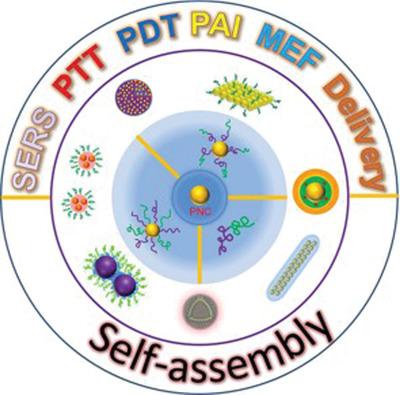当前位置:
X-MOL 学术
›
Macromol. Rapid Commun.
›
论文详情
Our official English website, www.x-mol.net, welcomes your
feedback! (Note: you will need to create a separate account there.)
Self‐Assembly of Polymer‐Coated Plasmonic Nanocrystals: From Synthetic Approaches to Practical Applications
Macromolecular Rapid Communications ( IF 4.2 ) Pub Date : 2018-11-19 , DOI: 10.1002/marc.201800613 Derong Lu 1 , Jiajing Zhou 1 , Yonghao Chen 1 , Jielin Ma 1 , Hongwei Duan 1
Macromolecular Rapid Communications ( IF 4.2 ) Pub Date : 2018-11-19 , DOI: 10.1002/marc.201800613 Derong Lu 1 , Jiajing Zhou 1 , Yonghao Chen 1 , Jielin Ma 1 , Hongwei Duan 1
Affiliation

|
Self‐assembly of plasmonic nanocrystals (PNCs) and polymers provides access to a variety of functionalized metallic‐polymer building blocks and higher‐order hybrid plasmonic assemblies, and thus is of considerable fundamental and practical interest. The hybrid assemblies often not only inherit individual characteristics of polymers and PNCs but also exhibit distinct photophysical and catalytic properties compared to that of a single PNC building block. The tailorable plasmonic coupling between PNCs within assemblies enables the precise control over localized surface plasmon resonance, which subsequently affords a series of light‐driven or photo‐activated applications, such as surface‐enhanced Raman scattering detection, photoacoustic imaging, photothermal therapy, and photodynamic therapy. In this review, the synthetic strategies of a library of PNC‐polymer hybrid building blocks and corresponding assemblies are summarized along with the mechanisms of polymer‐assisted self‐assembly of PNCs and the concepts for bridging the intrinsic properties of PNC‐polymer assemblies to widespread practical applications.
中文翻译:

聚合物涂层等离子体纳米晶体的自组装:从合成方法到实际应用
等离子体纳米晶体(PNC)和聚合物的自组装提供了访问各种功能化的金属聚合物构建基块和更高阶的混合等离子体组装的途径,因此具有相当大的基础和实践意义。混合组件通常不仅继承了聚合物和PNC的单独特征,而且与单个PNC构建基块相比,还表现出独特的光物理和催化特性。组件中PNC之间可定制的等离激元耦合实现了对局部表面等离振子共振的精确控制,从而提供了一系列光驱动或光激活的应用,例如表面增强拉曼散射检测,光声成像,光热疗法和光动力治疗。在这篇评论中,
更新日期:2018-11-19
中文翻译:

聚合物涂层等离子体纳米晶体的自组装:从合成方法到实际应用
等离子体纳米晶体(PNC)和聚合物的自组装提供了访问各种功能化的金属聚合物构建基块和更高阶的混合等离子体组装的途径,因此具有相当大的基础和实践意义。混合组件通常不仅继承了聚合物和PNC的单独特征,而且与单个PNC构建基块相比,还表现出独特的光物理和催化特性。组件中PNC之间可定制的等离激元耦合实现了对局部表面等离振子共振的精确控制,从而提供了一系列光驱动或光激活的应用,例如表面增强拉曼散射检测,光声成像,光热疗法和光动力治疗。在这篇评论中,











































 京公网安备 11010802027423号
京公网安备 11010802027423号